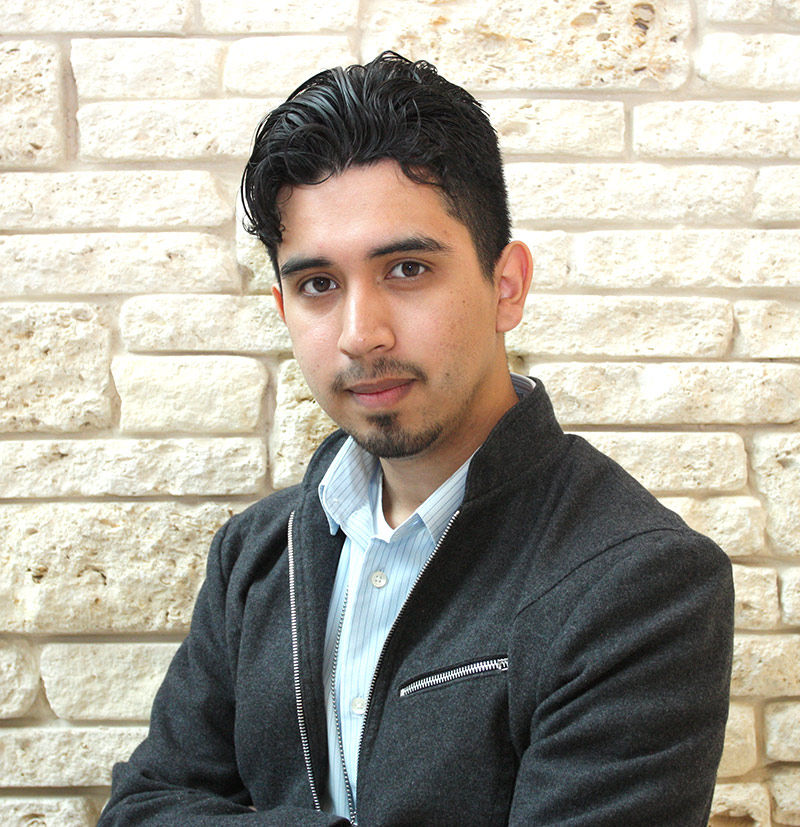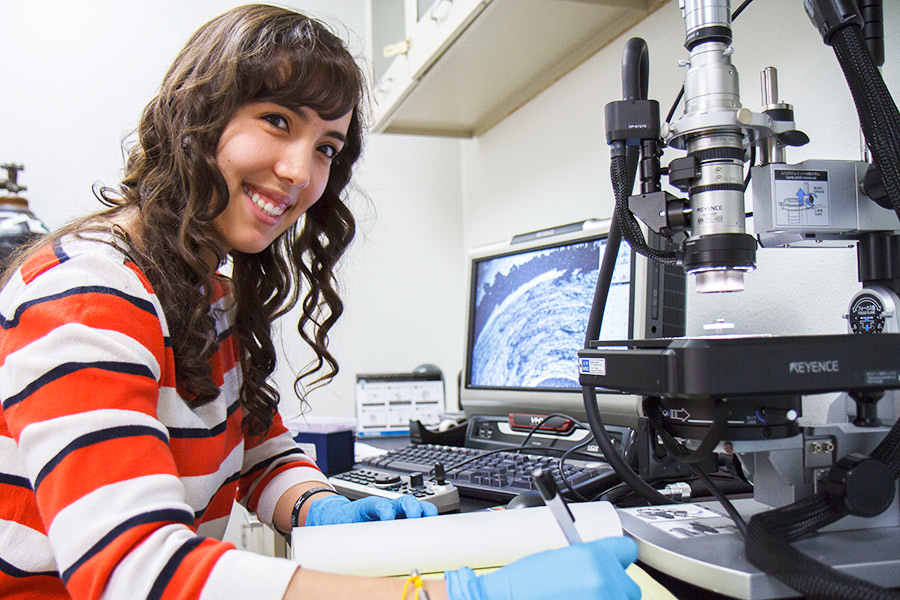Both UT Dallas recipients of a 2015 Graduate Research Fellowship (GRF) award from the National Science Foundation (NSF) hope to inspire others as they impact society through their scientific research.

Salvador Moreno
Salvador Moreno, a fast-track master’s candidate in mechanical engineering in the Erik Jonsson School of Engineering and Computer Science, is conducting interdisciplinary research on biodegradable implantable electronics and sensors with self-powered capability.
“Given the ever-rising health care costs, implantable sensors are promising affordable technologies for early diagnostic and prevention. However, their biocompatibility has been a major obstacle in their real-world applications,” he said. “I truly believe that my research, if successful, will provide a major breakthrough to bring these devices to application and impact the health care of our society.”
Outside of research labs, some of his most valuable experiences have been tutoring students in the Academic Bridge Program and working as a teaching assistant, he said.
“These experiences will help me as I aspire to become a professor,” Moreno said. “I hope to motivate creative minds and demonstrate, especially to minorities, that the lab is a place where people of different disciplines and ethnicities all work together on groundbreaking science.”
Maria Angelica Burbano Salazar, the other 2015 UT Dallas GRF recipient, will be among the first class of biomedical engineering students to graduate from the Jonsson School this spring. Her undergraduate education includes conducting research that earned recognition through the Barry M. Goldwater Scholarship and Excellence in Education program, and volunteer outreach activities through the Society of Hispanic Professional Engineers (SHPE).

Maria Angelica Burbano Salazar
“At various SHPE events, we would tell high school and college students that if you are resourceful and work hard, careers in science and technology are accessible,” she said. “I had a strong will but needed nudges along the way to apply for advanced opportunities. My volunteer activities and experiences earning academic scholarships taught me that sometimes people lack only in confidence and the expectation to advance in science. In the future, I would like to be the person giving others nudges to take risks and apply for opportunities beyond their expectations.”
Moreno and Burbano were chosen as NSF Graduate Fellows based on their demonstrated potential for significant achievements in science and engineering. The program is arguably the most competitive national fellowship awarded.
Summer Camp Inspires Path to University
Moreno earned his bachelor’s degree in mechanical engineering with a nanoscience minor last May, and is expected to graduate with his master’s degree in May. He will pursue his doctoral degree at UT Dallas starting in the fall.
Dr. Majid Minary, an assistant professor of mechanical engineering, advised Salvador’s senior design team, and his master’s and doctoral work.
“Salvador has been an outstanding student,” Minary said. “Their senior design project won the second place in our design competition, and he continued his graduate work with me. He is the co-author on a paper published in an American Chemical Society journal, and first author on a high-impact paper under submission from his graduate work.
“We are happy that Salvador has decided to stay with us at UTD for his PhD studies. I have no doubt he will continue to have positive impact on our University and on our nation and society in years to come. We are committed to help him toward this goal.”
Moreno, a Dallas native, was introduced to UT Dallas through the School of Science and Engineering at the Yvonne A. Ewell Townview Center. He attended a summer camp at UT Dallas where he was inspired to pursue mechanical engineering through exposure to robotics, programming and the Natural Science and Engineering Research Laboratory.
His work in the labs of Minary and Dr. Manuel Quevedo-Lopez, professor of materials science and engineering, included building the equipment needed to test their research. The use of the equipment carried over to his senior design project and master’s research. He will present some of his findings at an upcoming American Society of Mechanical Engineers conference.
“After graduate school, in addition to becoming a professor, I plan to start a small business to commercialize the testing equipment I developed in order to make research more affordable and accessible for high schools and small universities,” Moreno said. “My senior design project, a tensile state, for example, was designed to benchtop use so that it can fit under a microscope to observe deformation at a micro level. Introducing such tools to students at an early stage can spark interest in research.”
From Pre-Med Major to Bioengineering Researcher
UT Dallas allowed Burbano, a Colombia native, to engage her various research interests. She was originally a pre-medicine major, but a conversation with Dr. Danieli Rodrigues, assistant professor of bioengineering in the Jonsson School, opened her mind to other possibilities.
“Moving from Spain, I thought college was more like high school with specialized topics,” said Burbano, whose family followed her father’s career moves to Spain, England and Sweden. “I had never heard of conducting research and completing internships as an undergraduate student.”
Burbano conducted research in Rodrigues’ lab, completed an internship in Germany, collaborated with medical surgeons at UT Southwestern Medical Center and periodontists from Texas A&M University Baylor College of Dentistry. She also published papers and presented at conferences.
Burbano’s research experience includes characterizing the failure modes of metal-on-metal total hip implants and of foreign bodies embedded in dental tissue biopsies, and characterizing new coatings for dental implants that will combat bacterial infection and reduce wear of the implants.
NSF Graduate Research Fellowship Program
The National Science Foundation Graduate Research Fellowship Program recognizes and supports outstanding graduate students in NSF-supported science, technology, engineering and mathematics disciplines who are pursuing research-based master’s and doctoral degrees at accredited U.S. institutions.
The program provides three years of financial support — more than $30,000 annual stipend and $12,000 allowance to the graduate institution. Fellows also have other opportunities, such as participating in international collaborations through the Graduate Research Opportunities Worldwide initiative. The fellowship is part of the NSF’s overall strategy to ensure the nation’s leadership in advancing science and engineering research and innovation.
Since 1952, NSF has funded close to 50,000 Graduate Research Fellowships out of more than 500,000 applicants. Currently, 42 Fellows have gone on to become Nobel laureates, and more than 450 have become members of the National Academy of Sciences.
During her internship with a biomedical engineering company in Germany, she conducted research that directly applied to the improvement of medical devices sold to patients.
In May, Burbano will be one of the first to graduate with a bachelor’s degree in biomedical engineering from the Department of Bioengineering.
“One of the advantages of being part of a young program is that the teachers are very eager and excited to help you,” she said.
Burbano, who is interested in the mechanical side of biomedical engineering, will then pursue a doctorate in biomedical engineering at the University of Minnesota where she will complete rotations in neural engineering, cardiac devices and rehabilitation studies.
“A PhD offers me the opportunity to work in a position in a company where I can lead other scientists in the research and development of medical devices,” she said.
Rodrigues is confident Burbano will achieve her academic and professional goals.
“Maria has always been self-motivated and enthusiastic toward her research and classes,” Rodrigues said. “She has presented her research in a number of conferences and has worked with clinical collaborators in multiple projects. Since joining my lab, she has participated in four publications, being the first author in two of the articles. I am proud that the Goldwater organization and now the National Science Foundation are rewarding her diligence and investing in her potential.”